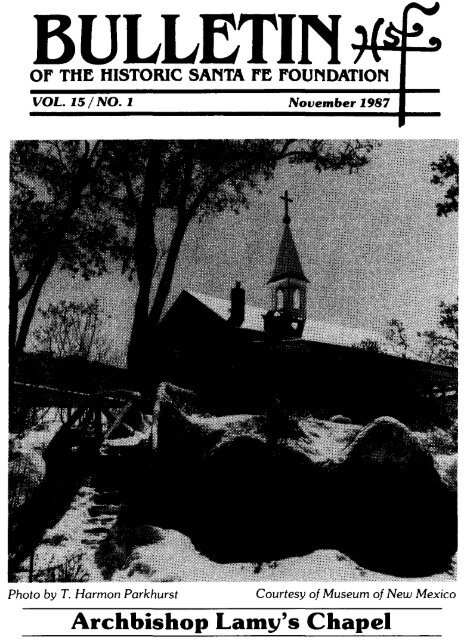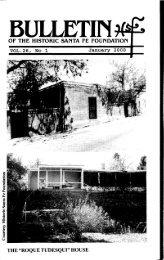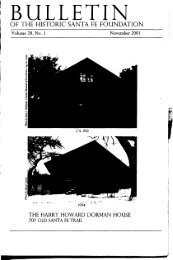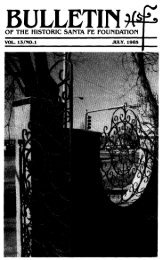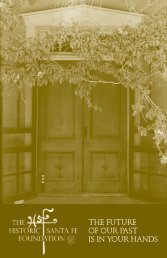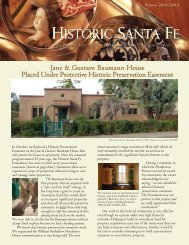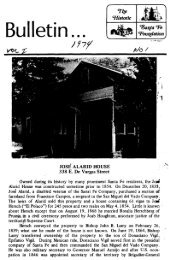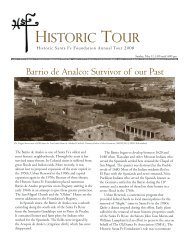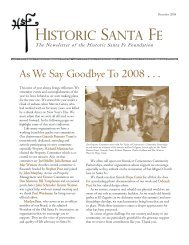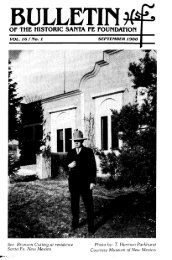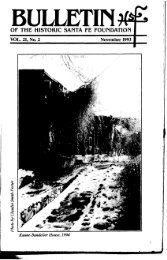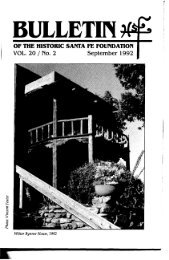Archbishop Lamy's Chapel - Historic Santa Fe Foundation
Archbishop Lamy's Chapel - Historic Santa Fe Foundation
Archbishop Lamy's Chapel - Historic Santa Fe Foundation
You also want an ePaper? Increase the reach of your titles
YUMPU automatically turns print PDFs into web optimized ePapers that Google loves.
BULLETIN<br />
Of' THf; HISTORIC SANTA f'f; f'OUNDATION<br />
VOL. 15/ NO.1 November 1987<br />
Photo by T. Harmon Parkhurst<br />
Courtesy of Museum of New Mexico<br />
<strong>Archbishop</strong> <strong>Lamy's</strong> <strong>Chapel</strong>
<strong>Archbishop</strong> <strong>Lamy's</strong> <strong>Chapel</strong><br />
This modest structure was built in<br />
the foothills north of <strong>Santa</strong> <strong>Fe</strong> by the<br />
first Bishop of New Mexico John B.<br />
Lamy in the late 1860's or early<br />
1870'sto serve as his private retreat.<br />
Born October 11, 1814 at Lempdes,<br />
France and christened Jean Baptiste,<br />
Lamy was educated and ordained<br />
in the Diocese of Clermont. In<br />
1839,with his friend and fellowpriest,<br />
Joseph Projectus Machebeuf, Lamy<br />
accompanied Bishop of Cincinnati<br />
J.B. Purcell, who had been recruiting<br />
missionary priests in France, to the<br />
United States. The young priests<br />
served in the Ohio mission field more<br />
than a decade.<br />
Meanwhile, New Mexico was occupied<br />
by Brigadier General Stephen<br />
Watts Kearny in 1846 and ceded to<br />
the United States by Mexico two<br />
years later in the Treaty of Guadalupe<br />
Hidalgo. Under Mexican sovereignty<br />
New Mexico had been under<br />
the ecclesiastical jurisdiction of the<br />
Bishop of Durango. In July, 1850, at<br />
the urging of the United States hierarchy,<br />
the Vatican created a provisional<br />
diocese separated from Durango,<br />
known as the Vicariate Apostolic<br />
of New Mexico and appointed Lamy<br />
as Vicar Apostolic. The new prelate,<br />
againaccompanied by Father Machebeuf,<br />
arrived a year later and in 1853<br />
the Diocese of <strong>Santa</strong> <strong>Fe</strong> was officially<br />
established with Lamy as its bishop.<br />
In the meantime, he had brought the<br />
Sisters of Loretto from Kentucky to<br />
open an academy in <strong>Santa</strong> <strong>Fe</strong>, and<br />
during the followingyears he enlisted<br />
European priests, as well as preaching<br />
and teaching orders, to serve in<br />
the episcopate.!<br />
contractors, stone masons and other<br />
artisans, especially from France and<br />
Italy. The most significant structure<br />
which they built was the stone<br />
Romanesque Cathedral of St. Francis<br />
in <strong>Santa</strong> <strong>Fe</strong> to replace the old<br />
adobe Spanish-period parroquia<br />
(parish church). Begun in 1869, but<br />
never fully completed under <strong>Lamy's</strong><br />
administration,2 it acquired greater<br />
status in 1875 when the Archdiocese<br />
of <strong>Santa</strong> <strong>Fe</strong> was established as a metropolitan<br />
see and Lamy was elevated<br />
to <strong>Archbishop</strong>.<br />
The busy prelate, faced with the<br />
problems of an extensive jurisdiction,<br />
frequently beset by controversy,<br />
felt it imperative to find a retreat<br />
where he could periodically take<br />
brief refuge from the cares of his<br />
office for quiet and meditation. This<br />
he found along the Little Tesuque<br />
stream, a few miles north of <strong>Santa</strong><br />
<strong>Fe</strong>. Some time during the 1860's<br />
Lamy purchased, for $80.00, a piece<br />
of land within the outer boundaries of<br />
the claimed, but never confirmed,<br />
Rio de Tesuque grant from Natividad<br />
Romero and his wife, Maria Vitalia<br />
Garcia, residents of the Rio de<br />
Tesuque settlement. The deed was<br />
not, however, recorded until October<br />
23,1874.3 The title to the land can<br />
be traced to 1752 when it was owned<br />
by a Juan de Ledesma. His widow<br />
deeded the tract to another widow,<br />
Maria Francisca de Sena in 1759.<br />
Senora Sena died in 1763, and <strong>Santa</strong><br />
<strong>Fe</strong> Alcalde Mayor Manuel Gallegos,<br />
in probating her estate on June 8,<br />
divided the land, "half of which is cultivated<br />
and half is uncultivated,"<br />
between her two minor children.4 At<br />
__a'_-' L __ 1700.~ 1Q':l7thD
OUl..1lCI~ I IVL VI I IlCl..Vl U. VV I It::: I I Lilt:::IOLlt:::1<br />
sold it to Natividad Romero, July 17,<br />
1837, he described it as: una suerte<br />
de tierra de pan llevar ("a piece of<br />
land for planting wheat"). The boundaries<br />
were given as: "on the east<br />
where the river joins the hill, following<br />
the river to where a little arroyo<br />
come out of it; on the west, the lands<br />
of Benito Garcia; on the north to the<br />
canada of Benavides; on the south<br />
the hill which divides the canoncito."s<br />
These limits were the identical<br />
ones stated in the deed from Romero<br />
and wife to Lamy, and were delineated<br />
in the customary Spanish<br />
method of citing geographical features,<br />
rather than by the Anglo<br />
American system of precise metes<br />
and bounds, and hence are confusing<br />
to interpret. The conveyance did<br />
not mention that any structures<br />
existed on the tract.<br />
The site was ideal for a retreat.<br />
The irrigation system was in place;<br />
the land was productive. On the hillside<br />
the bishop built his "lodge,"<br />
which he named Villa Pintoresca,<br />
obviously for the magnificent view.6<br />
It was an unpretentious building, but<br />
then Lamy was an unpretentious<br />
cleric. Undoubtedly he supervised<br />
the construction himself, and the<br />
result was a combination of traditional<br />
Hispanic New Mexican and<br />
European architectural features. It<br />
consisted of two small rooms, a bedroom<br />
and a sitting room, one on the<br />
north, the other on the south, separated<br />
by a hallway which led into the<br />
tiny chapel on the east. There he<br />
conducted his personal devotions<br />
and celebrated mass for frequent<br />
guests, sometimes assisted by a<br />
probably none-too-willing acolyte<br />
from St. Michael's School whom the<br />
archbishop enlisted to accompany<br />
1· .1.1 "1 11 '7<br />
""'111"'111)<br />
both<br />
allu W"'I'"<br />
the interior<br />
1I1UU-Vla::>Ll:::rl:::Uun<br />
and exterior, as<br />
they still are. The gable ends, however,<br />
were of wood, and the pitched<br />
roofs were apparently shingled from<br />
the beginning. A graceful steeple,<br />
with a plain wooden cross atop its<br />
spire, rose above the roof. A portal<br />
extended around the west and south<br />
sides. Allthese features are apparent<br />
in the earliest known photograph of<br />
the property. Although it is undated<br />
and the photographer unknown, this<br />
picture may actually have been taken<br />
before <strong>Lamy's</strong> death.8 The chapel<br />
has the same appearance as it does<br />
today, except that there is no window<br />
in the east wall of the south<br />
room and a small stoop-like structure<br />
over what may have been a low<br />
door juts out from the east chapel<br />
wall. This is borne out by later photographs,<br />
taken after this structure<br />
had disappeared, which show a lintel<br />
and a bricked-in doorway before the<br />
present window was cut in. If a door<br />
was originally in this location the altar<br />
must have been free-standing. Unfortunately,<br />
no photographs of the<br />
interior until relatively recent<br />
have been located.<br />
date<br />
Lamy was a horticulturalist of no<br />
mean ability. His garden and orchard<br />
around the <strong>Santa</strong> <strong>Fe</strong> residence was a<br />
show place. In his lush valley retreat<br />
along the Little Tesuque, with its<br />
abundance of water supplied by the<br />
old acequia, he set out shrubs and<br />
fruit trees, many of which he imported<br />
from France. Some are still<br />
bearing fruit. There may actually<br />
have been a few apricot and peach<br />
trees on the property when he<br />
bought it. One account speaks of a<br />
wagon load of peaches from his land<br />
taken to <strong>Santa</strong> <strong>Fe</strong> in 1873.9 He also<br />
planted gardens and flowers. A
Photos by T. Harmon Parkhurst.<br />
Courtesy of Museum of New Mexico
his visitors. He was indeed generous<br />
with his largesse and often invited the<br />
Sisters of Loretto, students from the<br />
academies, clergy, other friends and<br />
visitors to <strong>Santa</strong> <strong>Fe</strong> to picnic, enjoy<br />
the landscape and pick the fruit.<br />
The early photograph of the propt<br />
, " ••••••<br />
a garden. While they are too far away<br />
from the camera to be identifiable,<br />
one of them could even have been<br />
<strong>Archbishop</strong> Lamy himself. North of<br />
this enclosure cultivated areas lie on<br />
either side of the acequia, bordered<br />
by a row of trees on the east. A small,<br />
'" ..••• t. " '"
ouuomg, ro me soum or wmcn are<br />
two clumps of trees which may indicate<br />
the location of the ponds.ll<br />
According to contemporary accounts<br />
the <strong>Archbishop</strong> walked the<br />
more than three miles over the divide<br />
to his little rancho and expected his<br />
guests to do likewise. When General<br />
Charles Ewing, whose family had<br />
been parishioners of Lamy in Ohio,<br />
visited in November, 1881, however,<br />
his time was short and his host took<br />
him in a buggy to see the chapel.<br />
"The <strong>Archbishop</strong> drove me himself,<br />
and he drove like a Jehu," the<br />
general allegedly reported. 12 Another<br />
story states that some of his clergy<br />
visitors, not wishing to offend their<br />
chief pastor, but not relishing the<br />
long hike, rode horseback to the foot<br />
of the ridge, tethered their mounts to<br />
a pinon, walked over the hill to pay<br />
their visits, then returned to <strong>Santa</strong> <strong>Fe</strong><br />
in the same fashion.13<br />
As he gradually turned over his<br />
duties to his coadjutor J.B. Salpointe<br />
during the 1880's <strong>Archbishop</strong> Lamy<br />
spent more of his time at his Villa<br />
Pintoresca, finally staying there almost<br />
entirely. Early in <strong>Fe</strong>bruary,<br />
1888 he contracted a severe cold<br />
which developed into pneumonia<br />
and he was taken to the episcopal<br />
residence in <strong>Santa</strong> <strong>Fe</strong> where he died,<br />
<strong>Fe</strong>bruary 13, and was buried under<br />
the cathedral altar.<br />
With his death the land and chapel<br />
became the property of <strong>Archbishop</strong><br />
Salpointe. Titles to land dating from<br />
the Spanish and Mexican governments<br />
had still not been completely<br />
settled. In 1891 Congress created the<br />
Court of Private Land Claims to<br />
adjudicate the remaining unresolved<br />
claims. The chain of title derived<br />
from the Romeros was clouded, and<br />
in 1893 Salpointe filed a petition<br />
1'\10 oe 1esuque gram claim ro me<br />
north and the Juan de Gabaldon on<br />
the easLl4 The Gabaldon was finally<br />
approved, but the court rejected<br />
both that to the Bishop's Ranch and<br />
to the Rio de Tesuque, the titles of<br />
which were entertwined. Then, in<br />
1896 <strong>Archbishop</strong> Placide Louis <strong>Chapel</strong>le,<br />
Salpointe's successor, filed a<br />
Small Holdings Claim with the General<br />
Land Office, submitting affidavits<br />
by longtime <strong>Santa</strong> <strong>Fe</strong>an Solomon<br />
Spiegelberg as to <strong>Lamy's</strong> occupancy<br />
and of Francisco Ortiz de Tafoya<br />
concerning Garcia ownership. On<br />
March 20,1900 <strong>Chapel</strong>le was issued<br />
a patent for 152.8 acres which was<br />
approved by the Court of Private<br />
Land Claims in the final rejection of<br />
the larger granLIS<br />
There is no evidence that any of<br />
<strong>Lamy's</strong> successors actually occupied<br />
the livingquarters of the retreat, but<br />
the chapel remained in use. On<br />
November 11, 1909<strong>Archbishop</strong> John<br />
B. Pitaval conveyed the 152.8 acres<br />
to a Carl Stephan for $1,300.16 Four<br />
days later, November 15, 1909, Stephan<br />
sold it to Harper S. Cunningham<br />
for $1,800.17 Both deeds<br />
contained a phrase protecting the<br />
chapel: "reserving from the sale of<br />
certain <strong>Chapel</strong> situated in the above<br />
described premises, which said <strong>Chapel</strong><br />
is to be kept in good condition and<br />
repair by the Grantee at his own<br />
expense for the use and benefit of the<br />
Catholics of that vicinity and who<br />
shall be permitted to enter said premises<br />
for the purpose of worship in<br />
said <strong>Chapel</strong>." Two years later, December<br />
23, 1911, Evalina C. Cunningham,<br />
widow of Harper S, signed<br />
a warranty deed, which still contained<br />
the restrictive clause concerning<br />
the chapel, to May B. Woodford.<br />
Land values had increased; the pur-
deeded it to family members of the<br />
famous Pulitzer publishing company,<br />
William Scoville and Edith Pulitzer<br />
Moore and Constance Pulitzer. 19<br />
Two residences, later known as the<br />
south and north lodges, were built,<br />
as well as a carriage house, later<br />
incorporated into the present main<br />
structure of the present The Bishop's<br />
Lodge. An image made from a glass<br />
negative, probably taken by the photographer<br />
Bradfield about 1918,<br />
shows these structures. The only<br />
change in the exterior of the chapel is<br />
that the stoop or lean-to on the east<br />
wall had been removed and the lintel<br />
and bricked-in doorway are visible.20<br />
In spite of the rather pretentious<br />
north and south residences the<br />
tenancy of the Pulitzer family was of<br />
brief duration. On April 18, 1918<br />
William Scoville and Edith Pulitzer<br />
Moore (husband and wife), and Constance<br />
Pulitzer and husband William<br />
Gray Elmslie sold three tracts of<br />
land, comprising the original 152.8<br />
acres to the Bishop Lodge Corporation,<br />
headed by Colorado businessman<br />
James R. Thorpe II, and the<br />
property has remained in the control<br />
of the Thorpe family since that date.<br />
The price paid this time was $25,000<br />
- a far cry fromthe original $80 paid<br />
by Lamy to the Romeros.21 The restriction<br />
concerning the chapel was<br />
not part of the deed, but the Thorpe<br />
family has faithfully preserved and<br />
protected it for the benefit of visitors,<br />
retaining its exterior intact, while<br />
rehabilitating the interior which had<br />
fallen into disrepair. Some minor<br />
changes have been made, but none<br />
which alter the building's integrity.<br />
The present vigas appear to have<br />
replaced former rafters in ceiling<br />
construction. The floor of the hallway<br />
has been cemented, but the<br />
altar was probably that placed there<br />
by Lamy.<br />
Much of the interior work seems<br />
to have been done in 1928 under the<br />
supervision of New Mexico writer<br />
and tour guide Erna <strong>Fe</strong>rgusson, then<br />
a hostess at the Lodge, and artist<br />
Carlos Vierra. On July 29 of that year<br />
Erna invited her friend Willa Cather,<br />
of Death Comes for the <strong>Archbishop</strong><br />
fame, to the Lodge as a guest, partly<br />
to see the chapel which she and<br />
Vierra were responsible for "restoring,"<br />
suggesting that a visit from<br />
Cather might "supply the inspiration."<br />
Much of the work had been<br />
done, she wrote: "In the chapel, we<br />
have had Tesuque women to plaster,<br />
we shall white wash, repaint the<br />
woodwork and the altar and then<br />
consult the present Arch-Bishop as<br />
to what further might be done."22<br />
The well-known painting of the<br />
chapel by <strong>Santa</strong> <strong>Fe</strong> artist Theodore<br />
Van Soelen, also in 1928, and later<br />
photographs continue to show the<br />
outside of the chapel as it appears<br />
today. The only difference from the<br />
first photograph is that a small double<br />
window has been cut into the east<br />
wall of the south room and a painted<br />
window occupies the space of the<br />
former bricked-in doorway on the<br />
east wall of the chapel itself.<br />
Today, the simple little chapel built<br />
more than a century ago by a displaced<br />
French prelate in which to<br />
pray and retreat from the cares of an<br />
ecclesiastical jurisdiction in which he<br />
always felt he was in many ways an<br />
alien, still welcomes visitors for a few<br />
moments of peace and reflection.<br />
-Myra Ellen Jenkins<br />
FOOTNOTES<br />
I The most detailed biography of Lamy is that of Paul Hor·<br />
gan, Lamy of <strong>Santa</strong> <strong>Fe</strong>: His Life and Times (New York,<br />
1975). An older, but quite useful work is Louis H. Warner,<br />
<strong>Archbishop</strong> Lamy: an Epoch Maker (<strong>Santa</strong> <strong>Fe</strong>, 1936).<br />
2 A definitive account of 51. Francis Cathedral is Bruce T.
4 Both documents are in Spanish Archives of New Mexico,l,<br />
No. 854, State Records Center & Archives, <strong>Santa</strong> <strong>Fe</strong>, New<br />
Mexico.<br />
5 Deed Book F, pp. 77-78.<br />
6 Horgan, Lamy of <strong>Santa</strong> <strong>Fe</strong>, p. 374.<br />
7 Ibid, p. 420.<br />
8 This photograph is in the collections of the Photo-Archives,<br />
Museum of New Mexico, <strong>Santa</strong> <strong>Fe</strong>. Photo archivist Richard<br />
Rudisillagrees that it undoubtedly dates before the turn of<br />
the century, possibly from <strong>Lamy's</strong> occupancy.<br />
• Warner, <strong>Archbishop</strong> Lamy, p. 149.<br />
10 Horgan, Lamy of <strong>Santa</strong> <strong>Fe</strong>, p. 420.<br />
11 See note 8.<br />
12 Horgan, Lamy of <strong>Santa</strong> <strong>Fe</strong>, p. 420.<br />
13 Warner, <strong>Archbishop</strong> Lamy, p. ISO.<br />
14 Records of the Court of Private Land Claims, no. 125,State<br />
Records Center and Archives.<br />
15 Deed book Q-I, p. 169, General land Office Certificate<br />
#66.<br />
16 Deed Book l-2, p. 73.<br />
17 Deed Book l-2, p. 74.<br />
18 Deed Book l-2, p. SOl.<br />
I' Deed Book M-3, p. 107. This deed was not recorded until<br />
May I, 1918_<br />
20 This photograph is also in the Photo-Archives of the<br />
Museum of New Mexico .<br />
21 The deed was dated April 18, but was not recorded until<br />
July 19, 1918, Deed Book Q-I, p. 169.<br />
22 This letter is in the McFarlin Library, the University of<br />
Tulsa, Tulsa, Oklahoma_<br />
The John and Faith Meem<br />
Scholarship Prize for 1987<br />
This year, the Meem Prize for<br />
Scholarship was awarded to Meredith<br />
Phillips, a 1987graduate of <strong>Santa</strong><br />
<strong>Fe</strong> Preparatory School. This prize is<br />
presented each year, in the amount<br />
of $1000, to a student who, in the<br />
opinion of the Board of Directors of<br />
the <strong>Historic</strong> <strong>Santa</strong><br />
<strong>Fe</strong> <strong>Foundation</strong>,<br />
exhibits the strong moral conviction<br />
and intellectual acuity that is styled<br />
by inklings of the genuine modesty<br />
and gentleness so characteristic of<br />
the Meems.<br />
John Gaw Meems was a humanitarian,<br />
an architect of world renown,<br />
and a citizen of this community in the<br />
broadest sense. His contributions to<br />
the life of this area span the wide<br />
range of his many interests. His<br />
interests are carried on today by<br />
Faith Meem who shared in all of his<br />
various projects in <strong>Santa</strong> <strong>Fe</strong>.<br />
- - -- -....
Replastering The Las Trampas Church<br />
Dr. Jenkins and others inspect front I of church.
The photograph shows Dr. Myra<br />
rn f L= .1..= .LL_ .r:"_ ... _<br />
Several members of the <strong>Foundation</strong>,<br />
including Dr. Myra Ellen Jenkins<br />
and Agnesa and Jack Reeve<br />
were on hand to observe the restoration<br />
of the exterior of the Las Trampas<br />
Church. This plastering was<br />
done by local volunteers.<br />
Las Trampas is but one of many<br />
historic churches in New Mexico<br />
that are in desperate need of restoration<br />
and repair. Several major undertakings<br />
are underway to help in restoring<br />
these historic churches and<br />
preventing their further decay.<br />
Repairs at<br />
Cristo Rey<br />
Church<br />
In keeping with the <strong>Foundation</strong>'s<br />
purpose of furthering historic preservation,<br />
a grant of $5000 was made<br />
to Cristo Rey Church to replace the<br />
balcony roof beam which had deteriorated<br />
very badly. Carving on the<br />
beam was done by Father Ricardo<br />
Russo, a Franciscan priest, following<br />
the John Meem original plans. This<br />
church, with which Mr. Meem was so<br />
closely associated deserves our continuing<br />
support and that of all concerned<br />
citizens.
Replastering The Donaciano Vigil House
During the past year a portion of<br />
the exterior of the Donaciano Vigil<br />
House was replastered. This property<br />
has been plaqued by the <strong>Foundation</strong><br />
and is one of the more historic<br />
houses in <strong>Santa</strong> <strong>Fe</strong>. It is also on the<br />
State Register ot L..UlturalrruIJl:::l Lit:'"<br />
and it has been entered in the<br />
National Register of <strong>Historic</strong> Places.<br />
A fullreport on this interesting house<br />
appeared in the <strong>Foundation</strong> Bulletin<br />
of December 1984.
The 25th Anniversary of The<br />
<strong>Historic</strong> <strong>Santa</strong> <strong>Fe</strong> <strong>Foundation</strong><br />
The high point of last year's activities<br />
of the <strong>Foundation</strong> was the celebration<br />
of the 25th anniversary of the<br />
founding of the <strong>Foundation</strong>. A large<br />
group of members gathered at the<br />
Randall Davey house last September<br />
on a gloriously beautiful afternoon to<br />
honor the founders of the organization<br />
and to celebrate this important<br />
date. Awards were presented to the<br />
original Board members, most of<br />
whom were in attendance, with a<br />
special presentation to Faith Meem.<br />
There was also a rendition of the<br />
<strong>Foundation</strong>'s own song which, even<br />
though a little less than opera quality,<br />
was thoroughly enjoyed by all.
Education Committee Needs HELP!<br />
The <strong>Historic</strong> <strong>Santa</strong> <strong>Fe</strong> <strong>Foundation</strong><br />
was incorporated, in part " ... to<br />
engage in other educational activities<br />
to preserve and maintain the historic<br />
landmarks and structures of <strong>Santa</strong><br />
<strong>Fe</strong>." The Education Committee consisting<br />
of Louann Jordan and Edward<br />
Gonzales, is beginning an ambitious<br />
project to bring preservation education<br />
to <strong>Santa</strong> <strong>Fe</strong>'s grade schools. Part<br />
one of the project willbe an activities<br />
book based on <strong>Santa</strong> <strong>Fe</strong> architecture<br />
to be used by 4th grade social studies<br />
classes.<br />
The Committee is looking for a 4th<br />
grade teacher (or ex-teacher) who is<br />
interested in helping with this project.<br />
Ifyou are interested, call Louann<br />
Jordan at 983-2994.<br />
The Roque Tudesque House<br />
The <strong>Foundation</strong> Agrees to a Major<br />
Purchase of a <strong>Historic</strong> House<br />
Your <strong>Foundation</strong> recently completed<br />
arrangements to purchase the<br />
Roque Tudesqui House on East<br />
DeVargas Street from the estate of<br />
the late Marjorie Allen. In her will,<br />
Miss Allen had very kindly given the<br />
<strong>Foundation</strong> the right of first refusal<br />
on her property in the event that her<br />
heirs did not want to hold on to the<br />
house-which they chose not to do.<br />
The importance of the <strong>Foundation</strong><br />
acquiring this historic residence cannot<br />
be overstated. Even though it<br />
was plaqued by the <strong>Foundation</strong> in<br />
1964 and is included in the National<br />
Register as a National <strong>Historic</strong> Site,<br />
there has been a plan put forth by the<br />
State of New Mexico to obtain this<br />
property and others in this area<br />
known as the Barrio de Analco for<br />
conversion into a parking lot. The<br />
never been understood. It was only<br />
through a massive effort by the<br />
<strong>Foundation</strong> and other concerned<br />
people in <strong>Santa</strong> <strong>Fe</strong>, Albuquerque and<br />
elsewhere in New Mexico that the bill<br />
introduced in the legislature never<br />
came to a vote and was withdrawn.<br />
Control of this house by the <strong>Foundation</strong>,<br />
along with the concern of all<br />
interested citizens will help to pre·<br />
vent schemes of this sort in the<br />
future, even though there is no telling<br />
what the State may attempt to do.<br />
The next Bulletin will include an<br />
article concerning the background<br />
and history of this important historic<br />
house. In the meantime, the <strong>Foundation</strong><br />
welcomes the financial support<br />
of any donors who wish to be a part<br />
of the purchase of this property.<br />
Checks in any amount you can
The <strong>Historic</strong> <strong>Santa</strong> <strong>Fe</strong> <strong>Foundation</strong><br />
Education Fund To Support Professionals<br />
Two <strong>Santa</strong> <strong>Fe</strong> Preservation Specialists<br />
were accepted for positions in<br />
the Architectural Conservation Program<br />
at the Rome International Center<br />
for the Preservation and Restoration<br />
of Cultural Properties. They<br />
were two of only three Americans to<br />
attend the six month session.<br />
The <strong>Santa</strong> <strong>Fe</strong> <strong>Historic</strong> <strong>Foundation</strong><br />
Education Committee recommended<br />
that, in addition to the annual John<br />
Gaw Meem Prize for a high school<br />
graduate, additional grants be made<br />
available for professionals in the field<br />
of historic preservation for further<br />
education purposes.<br />
The <strong>Historic</strong> <strong>Santa</strong> <strong>Fe</strong> <strong>Foundation</strong><br />
was happy to announce that a grant<br />
of $500 each would be made to Barbara<br />
Zook, of the New Mexico <strong>Historic</strong><br />
Preservation Bureau and to<br />
Mike Romero Taylor, Preservation<br />
Chief for the State of New Mexico<br />
Monuments Division. They have<br />
returned to this country after their<br />
studies abroad and have reported to<br />
the <strong>Foundation</strong> that they got a great<br />
deal out of the program and that their<br />
experience willenhance their efforts<br />
in historic preservation in <strong>Santa</strong> <strong>Fe</strong><br />
and throughout the State of New<br />
Mexico.<br />
Membership Activities<br />
This year, instead of the usual<br />
tour of a historic site or a group of<br />
historic houses, the Membership<br />
Activity Committee, headed by Pen<br />
La Farge, sponsored a tour of contemporary<br />
houses in <strong>Santa</strong> <strong>Fe</strong>.<br />
Each house was open to <strong>Foundation</strong><br />
members during the afternoon<br />
of Sunday, August 30. A great deal<br />
of interest was shown in these<br />
unusual houses.<br />
The tour included the house at<br />
795 Camino del Monte Sol at the<br />
corner of Camino Cruz Blanca, the<br />
". 1 L n~_L , l' 1<br />
Mrs. Sonny Otero, and Ahkon Povi<br />
in La Tierra built by John McGowan<br />
as an experimental showcase<br />
for solar technology.<br />
On Sunday, September 17, a<br />
Membership tea was held at the<br />
<strong>Fe</strong>lipe B. Delgado House on Palace<br />
Avenue. This house was donated to<br />
the <strong>Foundation</strong> in 1980by John and<br />
Faith Meem and it is now used to<br />
house the special banking offices of<br />
the First National Bank. Those attending<br />
the tea were very interested<br />
in seeing this historic building<br />
11 ", , 1
Bulletins of the <strong>Historic</strong><br />
<strong>Santa</strong> <strong>Fe</strong> <strong>Foundation</strong><br />
From time to time, the <strong>Foundation</strong> publication date and the main feature<br />
publishes a Bulletin like the one you covered.<br />
are reading now. Most Bulletins contain<br />
There are still a few copies of these<br />
a feature article on a subject of Bulletins available, but some issues<br />
historic interest and we thought that are completely gone. Ifyou are interested<br />
readers might be interested in which<br />
in obtaining a copy of any past<br />
subjects were covered in past Bulletins.<br />
Bulletin, please call the <strong>Foundation</strong><br />
The following list shows that office at 983-2567 and we will try to<br />
help you.<br />
Year<br />
House or Public Building<br />
1974<br />
Jose Alarid House<br />
338 E. DeVargas<br />
1975 (?)<br />
1975<br />
Spring/Summer<br />
1976<br />
Fall/Winter<br />
1976<br />
March/April<br />
1977<br />
June/July<br />
1977<br />
Nov/Dec<br />
1977<br />
May/June<br />
1978<br />
Sept/Oct<br />
1978<br />
January 1979<br />
June/July<br />
1979<br />
January 1980<br />
September 1980<br />
June 1981<br />
George Cuyler Preston House<br />
Fort Marcy Officer's Residence<br />
Hayt-Wientge Mansion<br />
AM. Bergere House<br />
EIZaguan<br />
Second Ward School<br />
Eugenie Shonnard House<br />
WilliSpiegelberg House<br />
Digneo-Valdes House &<br />
Digneo-Moore House<br />
Carlos Vierra House<br />
First Ward School<br />
Ignacio de Roybal House<br />
Manderfield Mausoleum<br />
Roque Tudesqui House<br />
Gregorio Crespin House<br />
Loretto Chanel Harmonium<br />
106 Faithway<br />
116 Lincoln<br />
620 Paseo de la Cuma<br />
135 Grant Avenue<br />
545 Canyon Road<br />
312 Sandoval Street<br />
1411 Paseo de Peralta<br />
237 Palace Avenue<br />
1231 Paseo de Peralta<br />
1233 Paseo de Peralta<br />
1002 Old Pecos Trail<br />
400 Canyon Road<br />
Pojoaque Valley<br />
Rosario Cemetery<br />
129-135 East de Vargas<br />
132 East de Vargas<br />
Loretto Chanel
n<br />
34<br />
May 1982 Las (<strong>Santa</strong> Nusbaum Fairview (Annual Donaciano Salmon-Greer<br />
(<strong>Historic</strong> (Symposia, Acequias <strong>Fe</strong>Meetings, Cemetery Preservation House-Origination VigilHouse etc.) 1945 and 518 Demolished Nambe' Don Plaques, Alto in Gaspar 1915) <strong>Santa</strong> Street etc.) of & <strong>Fe</strong>)<br />
Paseo de Peralta<br />
Plaza<br />
1987 Committee Assignments<br />
Finance<br />
Stephen E. Watkins, Ex-Officio Chairman<br />
Don D. Van Soelen<br />
Endangered Properties<br />
Dale F. Zinn, Chairman<br />
Education<br />
Louann Jordan, Chairman<br />
Edward L. "Gonzo" Gonzales<br />
Publications<br />
Richard C. Davis, Chairman<br />
Agnesa Reeve<br />
Louann Jordan<br />
Revolving Fund<br />
Dale F. Zinn<br />
<strong>Historic</strong> Research<br />
Corinne Sze, Chairman<br />
Edmundo R. Delgado, Vice Chairman<br />
Jordie Chilson<br />
Myra Ellen Jenkins<br />
Howard Kastner<br />
Mary Amelia Whited<br />
Membership Activities<br />
Pen La Farge, Chairman<br />
Jordie Chilson
, (1)** 647 219Yz -87501 -87504<br />
127 Old East Delgado <strong>Santa</strong> Lupita 1906Street<br />
<strong>Fe</strong> Trail<br />
--<br />
" ~ 1"1 A•• ,.. _nn yo-. /""'II •... • n,...,,.,<br />
1987 1988 1989 (2) P.O. Photo Old 1042Arroyo Stagecoach Box Archives, 756, Chamisa 87504 Museum RoadRd.<br />
**Completing<br />
Jordie Chilson<br />
vacated term<br />
Ending*P.O. Address Route 1524 112 1325<br />
Board Telephone<br />
983-5605 983-2994 988-1885 983-1664 983-4592 982-8690 827-6472 988-3713 983-8377 982-4659 988-9646 455-3177 982-9315 Camino Don Box 11, 2325 Box Gaspar Escondido Sierra 85-AVista<br />
#2<br />
of Directors<br />
1987<br />
Term
Membership<br />
Although the <strong>Foundation</strong> currently has a large and enthusiastic membership,<br />
we would like to encourage anybody with an interest in <strong>Historic</strong> Preservation<br />
and who is not now a member to consider joining. The old adage that in numbers<br />
there is strength is certainly true and, as we see the constant erosion of historic<br />
buildings and even whole neighborhoods, the burden fallson each and everyone<br />
of us to do something about it. One way to help is to join the <strong>Historic</strong> <strong>Santa</strong> <strong>Fe</strong><br />
<strong>Foundation</strong> and assist it in its educational and preservation activities. Please<br />
take a moment to send in the membership application below. The fee is small<br />
and the benefits can be great.<br />
THE HISTORIC<br />
SANTA FE FOUNDATION<br />
P.O. Box 2535 ... <strong>Santa</strong> <strong>Fe</strong>, New Mexico ... 87501<br />
ANNUAL MEMBERSHIP DUES, 19<br />
Individual $ 6.00<br />
Husband and Wife .<br />
Commercial .<br />
Sustaining .<br />
Life .<br />
10.00<br />
15.00<br />
50.00<br />
1,000.00<br />
To help preserve the historic<br />
buildings and sites of <strong>Santa</strong> <strong>Fe</strong> .......................... $<br />
TOTAL (Income Tax Deductible)<br />
$<br />
o I would like to volunteer<br />
NAME<br />
ADDRESS ___________ ZIP _


